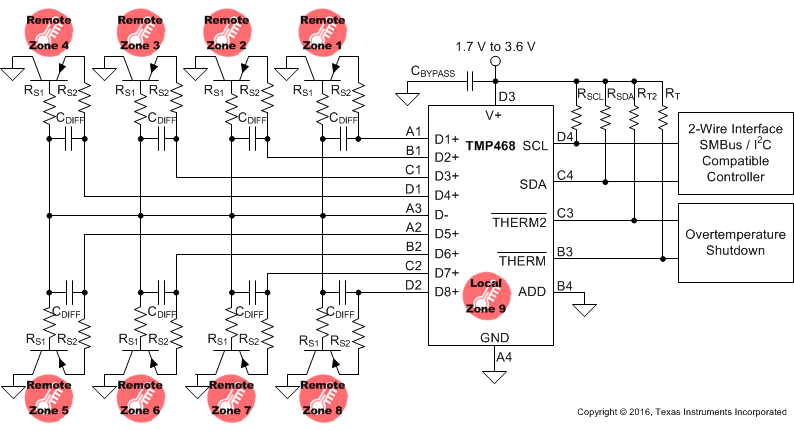SBOS762B November 2016 – June 2017 TMP468
PRODUCTION DATA.
- 1 Features
- 2 Applications
- 3 Description
- 4 Revision History
- 5 Pin Configuration and Functions
- 6 Specifications
-
7 Detailed Description
- 7.1 Overview
- 7.2 Functional Block Diagram
- 7.3 Feature Description
- 7.4 Device Functional Modes
- 7.5 Programming
- 7.6
Register Maps
- 7.6.1
Register Information
- 7.6.1.1 Pointer Register
- 7.6.1.2 Local and Remote Temperature Value Registers
- 7.6.1.3 Software Reset Register
- 7.6.1.4 THERM Status Register
- 7.6.1.5 THERM2 Status Register
- 7.6.1.6 Remote Channel Open Status Register
- 7.6.1.7 Configuration Register
- 7.6.1.8 η-Factor Correction Register
- 7.6.1.9 Remote Temperature Offset Register
- 7.6.1.10 THERM Hysteresis Register
- 7.6.1.11 Local and Remote THERM and THERM2 Limit Registers
- 7.6.1.12 Block Read - Auto Increment Pointer
- 7.6.1.13 Lock Register
- 7.6.1.14 Manufacturer and Device Identification Plus Revision Registers
- 7.6.1
Register Information
- 8 Application and Implementation
- 9 Power Supply Recommendations
- 10Layout
- 11Device and Documentation Support
- 12Mechanical, Packaging, and Orderable Information
Package Options
Mechanical Data (Package|Pins)
Thermal pad, mechanical data (Package|Pins)
- RGT|16
Orderable Information
1 Features
- 8-Channel Remote Diode Temperature Sensor Accuracy: ±0.75°C (Maximum)
- Local and Remote Diode Accuracy: ±0.75°C (Maximum)
- Local Temperature Sensor Accuracy for the DSBGA Package: ±0.35°C (Maximum)
- Temperature Resolution: 0.0625°C
- Supply and Logic Voltage Range: 1.7 V to 3.6 V
- 67-µA Operating Current (1 SPS, All Channels Active)
- 0.3-µA Shutdown Current
- Remote Diode: Series Resistance Cancellation,
η-Factor Correction, Offset Correction, and Diode Fault Detection - Register Lock Function Secures Key Registers
- I2C or SMBus™ Compatible Two-Wire Interface With Pin-Programmable Address
- 16-Bump DSBGA and 16-Pin VQFN Packages
2 Applications
- MCU, GPU, ASIC, FPGA, DSP, and CPU Temperature Monitoring
- Telecommunication Equipment
- Servers and Personal Computers
- Cloud Ethernet Switches
- Secure Data Centers
- Highly Integrated Medical Systems
- Precision Instruments and Test Equipment
- LED Lighting Thermal Control
3 Description
The TMP468 device is a multi-zone, high-accuracy, low-power temperature sensor using a two-wire, SMBus or I2C compatible interface. Up to eight remote diode-connected temperature zones can be monitored simultaneously in addition to the local temperature. Aggregating the temperature measurements across a system allows improved performance through tighter guard bands and can reduce board complexity. A typical use case is for monitoring the temperature across different processors, such as MCUs, GPUs, and FPGAs in complex systems such as servers and telecommunications equipment. Advanced features such as series resistance cancellation, programmable non-ideality factor, programmable offset, and programmable temperature limits are included to provide a robust thermal monitoring solution with improved accuracy and noise immunity.
Each of the eight remote channels (and the local channel) can be programmed independently with two thresholds that are triggered when the corresponding temperature is exceeded at the measured location. In addition, there is a programmable hysteresis setting to avoid constant toggling around the threshold.
The TMP468 device provides high accuracy (0.75°C) and high resolution (0.0625°C) measurement capabilities. The device supports low voltage rails (1.7 V to 3.6 V), common two-wire interfaces, and is available in a small, space efficient package (3 mm × 3 mm or 1.6 mm × 1.6 mm) for easy integration into computing systems. The remote junction supports a temperature range from –55°C to +150°C.
Device Information(1)
| PART NUMBER | PACKAGE | BODY SIZE (NOM) |
|---|---|---|
| TMP468 | DSBGA (16) | 1.60 mm × 1.60 mm |
| VQFN (16) | 3.00 mm × 3.00 mm |
- For all available packages, see the orderable addendum at the end of the data sheet.
